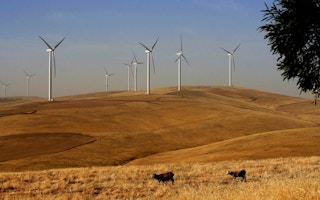In the wake of South Australia’s wild weather and state-wide blackout, both Prime Minister Malcolm Turnbull and Energy Minister Josh Frydenberg have emphasised the importance of energy security.
Turnbull stated that the blackout was a wake-up call, suggesting that reliance on renewables places very different strains and pressures on a grid than traditional coal-fired power.
The assumption that these politicians and others are working off is that South Australia’s wind industry has reduced the state’s energy security.
But do these politicians really know what energy security means in a modern energy landscape?
The baseload question
Baseload power is an economic term that refers to power sources that consistently generate electrical power, therefore meeting minimum demand. The minimum demand for electrical power from an electrical grid is referred to as the baseload requirement.
The underlying assumption is that the only way of supplying baseload electricity demand is by means of power stations, such as those fired by coal, that operate at full power all day and night. This is a widely held belief in Australia.
A former Australian industry minister, Ian Macfarlane, claimed at a uranium industry conference that the only serious alternative way that baseload power can be produced is by hydro and nuclear.
But this is not entirely true. In 2014, South Australia got 39 per cent of its electricity from renewable energy (33 per cent wind plus six per cent solar). Consequently, the state’s coal-fired power stations have become redundant.
To date, despite a couple of teething problems, the system has operated reasonably well given the enormous transitional challenge.
It has strongly demonstrated the ability to achieve energy security via an energy mix that combines renewables, gas and a small amount of imported power from Victoria. The South Australian system also highlights the fact that baseload power is not synonymous with fossil fuels.
“
A secure energy future depends on energy diversity.
Across Australia, many coal-fired power stations have been operating at reduced capacity. For example, the Mount Piper power station near Lithgow, New South Wales, has been operating at only 45 per cent capacity despite the closure of the nearby Wallerawang coal plant.
In this context, diversity of renewable energy sources is key. Wind and solar are dependent on the right weather to generate electricity. But fluctuations in energy generation can be balanced with alternatives that can supply power on demand, such as hydro, concentrated solar thermal power (CST) or bio-fuelled open-cycle gas turbines.
Spreading out wind and solar PV farms also reduces this variation. Wind and solar must also be connected with new transmission lines to achieve wide geographic distribution and ensure diversity is promoted within the grid.
We also need smart energy management. It is possible to shave off peaks during periods of high electricity demand by using smart meters and consumer-controlled switches. These devices allow consumers to turn off power-intensive facilities, such as air conditioning, water or heating, for short periods when demand on the grid is high or supply is low.
Two sides of the same coin
Energy security is not about traditional baseload power production. It is really about the capacity of households, businesses and government to accommodate disruptions in the supply in energy markets. This doesn’t just mean weather, it also means broader changes that are shaking up the energy sector.
The primary global driver changing our approach to energy production is climate change, a direct product of carbon-intensive emissions produced by traditional baseload power generation.
Reducing greenhouse gas emissions is crucial for human flourishing. Reducing our dependency on fossil fuel power stations and shifting to a renewable energy mix is one way to achieve this.
For example, if and when the Hazelwood power station in Victoria closes, it will be the product of the inevitable shift away from carbon-intensive energy production.
The closure will produce a significant decrease in traditional baseload power. It will inevitably affect supply to other states, including South Australia, New South Wales and Tasmania, as Hazelwood (through the eastern Australian transmission network) provides power to each of these states.
In this context, a secure energy future depends on energy diversity. Traditional baseload power needs to be replaced with a mix of renewable energy sources that combined are capable of achieving the equivalent of baseload power.
Dealing with more renewables
Energy security demands speeding up rather than slowing down renewable energy production and diversification.
Improving storage for wind and solar production is a priority, as is improving connectivity between the states, with the aim of increasing the renewable energy traded across borders.
Micro-grid technology will also be crucial. Microgrids are essentially localised grids that have the capacity to disconnect from the traditional grids and operate on their own. This can help reduce grid disturbances and strengthen resilience. Microgrids are important because they serve local energy loads and, in so doing, reduce losses in transmission and distribution.
Some states have already implemented strategic groups to assess the energy security issues they are facing. For example, the Tasmanian Energy Security Taskforce was implemented in 2016 with the specific aim of examining how the state’s energy security can be strengthened and improved.
The consultation paper recently released by the taskforce states that energy security in Tasmania must focus on meeting long-term energy demand to a level of energy reliability that consumers will be prepared to pay for.
The taskforce will examine the potential for reduced Basslink exports at high prices in Victoria, the costs of competing fuel sources for generation, and the costs associated with developing new generation and the associated system reinforcements.
The Tasmanian taskforce seeks to examine a range of inter-related factors that include: progressing an energy mix in renewables; reducing energy security risks from extreme weather events such as storms and bushfires; and examining how much cost consumers are willing to assume to transition energy production to achieve a higher level of energy security for the state.
The one thing these developments reveal is that energy security, both in Australia and globally, is not about going backwards to some outdated reliance upon fossil-fuelled baseload power. Energy security is about new forms of baseload power.
Its success will ultimately depend upon our capacity to transition our energy systems as we head towards our new energy future.
![]()
Samantha Hepburn, Director of the Centre for Energy and Natural Resources Law, Deakin Law School, Deakin University. This article was originally published on The Conversation.











